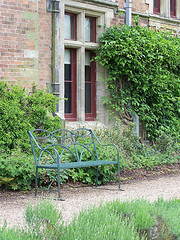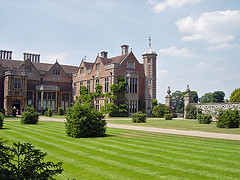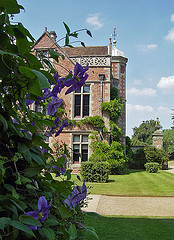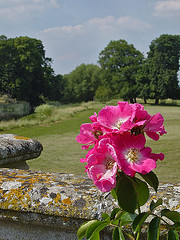The Lucy Family of Charlecote
. . . . . . near Stratford on Avon . . . . . .
The Lucy family are well known for their link to Shakespeare -
did he poach their deer?
Not so well known is their close link to the Whitney family,
who may be of such importance in the story of
Christopher Marlowe.

Here is a little about the family...
(quote)
Robert Whitney, eldest son of Eustace, succeeded him when only fifteen years of age, and, when not more than eighteen, married Anne,, daughter of Sir Thomas Lucy, Knight, of Charlecote in Warwick-shire.
This was the same Lucy who prosecuted William Shakspere for poaching and was lampooned by the latter, in revenge, as "Justice Shallow."
According to all other authorities he was a worthy gentle-man.
Charlecote is one of the most beautiful spots in England and an object of interest for all visitors to the Shakspere country.
..................................................................................................................................................................................
By comparing the pedigrees shown in the Appendix with the Whitney register, we find that there wore born to Robert and Anne no less than twelve children, viz.:
1. Constance, born about 1610, and buried in St. Giles without Cripplegate, London, May 25, 1628, whose epitaph we shall have occasion to mention.
..........................................................................
As already noted, his eldest daughter had long be- fore been laid beneath the pavement of St. Giles, where sleep John Milton, John Fox, Sir Martin Fro- bisher and others of world-wide fame.
Mr. Baddeley, in his interesting account of this church,2 thus de- scribes her monument, a photograph of which is here shown:
CONSTANCE WHITNEY, Buried May 25th, 1628.
This very curious monument on the wall in the north aisle has given rise to much speculation as to its meaning.
It represents a woman in her grave clothes rising from her coffin, and with hands outstretched receiving from a cherub on each side a crown and a chaplet. It is no doubt intended
to be emblematic of the Resurrection; but a legend has been handed down from one church custodian to another, that "it represents a woman awakening from a trance, into which she had fallen, and in which state she had been buried. The Sexton in his desire to possess himself of a valuable ring she wore, cut her finger to obtain it, and in doing so, awakened and saved her from a horrible death." It is further stated that she returned home to her husband, and became the mother of several children, but the fact that the inscription on the monument states, amongst other thing; that she died at the early age of 17, is surely inconsistent with such a tale.
There is no date given on the monument, but the Regis- ter's record is "Mrs. Constance Whitney, Buried May 25th, 1628." The title Mrs. or Mistress was not restricted then, as now, to married ladies.
............................................................................................................................................................
............................................................................................................................................................
1 By Mr. Green, in introduction to "Works of Geoffrey Whitney."
2 An "Account of the Church and Parish of St. Giles without Cripple- gate, in the city of London," by John James Baddeley, Churchwarden, 1887.
[Picture omitted]
MONUMENT OF CONSTANCE WHITNEY.
In Church of St. Giles, without Cripplegate, London.
The Last of the Whitneys of Whitney 185
.............................................................................................................................................................
.............................................................................................................................................................
The inscription, on the representation of a coffin, runs as follows:
TO THE MEMORIE Of Constance Whitney, eldest daughter to Sr. Robert Whitney, of Whitney, the proper possession of him and his an- cestors, in Herefordshire for above 500 years past.
Her mother was the fowrth daughter of Sir Thomas Lucy of Charlecote, in Warwickshire, by Constance Kingsmel, daughter and heyre of Richard Kingsmel, surveiour of the Court of Wardes. This lady Lucy her grandmother soe bred her, since she was 8 years old, that she excelled in all noble qualities becomminge a Virgin: Of so sweete proportion of beauty and harmonic of parts, Shee had all sweetnesse of manners answerable, A delightfull sharpeness of witt, An offensles modestie of conversation, A singular respect and pietie to her parents, But religious even to example.
186 The Ancestry of John Whitney
She departed this life most Christianly at seauenteene, dyeing the griefe of all, but to her grandmother an unre- coverable loss, save in her expectation shee shall not stay long after her, and the comfort of knowing whose shee is, and where in the resurrection to meete her.
http://www.whitneygen.org/archives/extracts/melville/vi.html
..................................................................................................................................................................................

In the Church of St. Giles, Cripplegate, London, (where are the graves of Milton and John Fox) in the wall, near the clock, is the massive monument, to Constance Whitney, a grand-daughter of Sir Thomas Lucy, of Charlecote, who prosecuted Shakespeare for poaching.
It represents a woman rising from her coffin. A legend says: After the young lady ws buried, the verger descended into her vault, opened the coffin, and began to cut off the finger of the maiden on which a precious ring had been left. On the knife entering the flesh she rose, and it ws found that Miss Whitney had been interred alive, a deep trance having been taken for death. But it was probably intended to be emblematic of the Resurrection.
There is no date on the monument, but on the Church Register, in the columns of "Burialls in May 1628" is "Mrs. Constance Whitney, gentlewoman." The title of Mrs. or Mistress was not then used, as now, to denote married women only.
The inscription is as follows: TO THE MEMORIE of Constance Whitney, eldest daughter to Sr. Robert Whitney, of Whitney, the proper possession of him and his ancestors, in Herefordshire for above 500 yeeres past. Her mother was the fowrth daughter of Sir Thomas Lucy of Charlecote, in Warwickshire, by Constance Kingsmel, daughter and heyre of Richard Kingsmel, surveiour of the Court of Wardes, this lady Lucy her grandmother, soe bred her, since shee was 8 years old, that shee excelled in all noble qualities becomminge a virgin: of so sweete proportion of beauty and harmonie of parts, shee had all sweetnesse of manners answerable, a delightfull sharpeness of witt, an offensles modestie of conversation, a singuler respect and pietie to her parents, but religious even to example.
She departed this life most Christianly at seaventeene, dying the griefe of ll, but to her grandmother an unreoverable loss, save in her expectation shee shall not sty long after her, and the comfort of knowing whose shee is, and where in the resurrection to meete her.*
http://www.whitneygen.org/archives/extracts/some.html
...............................................................................................................................................................................
Some of the early Lords of Whitney were of Welsh descent, one of whom, Sir Piedge Exrog, was a Knight of the Round Table, and "to King Arthyr's time he lived att his castle att Cardmore at Cardiganshire."*
* Most of the foregoing with much more of the early history, is to be found in Whitney as a Surname.
http://www.whitneygen.org/archives/extracts/some.html
.........................................................................................................................................................................................
The church where Constance Whitney has her memorial, also has other Shakespearean associations.
..........................................................................................................................................................................................
"Another legendary poet with connections to St Giles is William Shakespeare.
Two of his nephews were christened here, one was buried here, and interred here in 1634 was the grand-daughter of Sir Thomas Lucy, supposedly the basis of the comic 'Justice Shallow' in Henry IV Part II and The Merry Wives Of Windsor.
Shakespeare's fellow actor and local benefactor Edward Alleyn is memorialised by a stained glass window - he was the proprieter of the Fortune Theatre which once stood close by."
http://www.ourpasthistory.com/london/st_giles_cripplegate.htm
......................................................................... ......................................................................... .........................................................................






picures one to seven are by brettdotsmith
the next five are by Jezzebelle
the final picture is by tico_bassie
all pictures are at flickr - licensed under creative commons
home or index